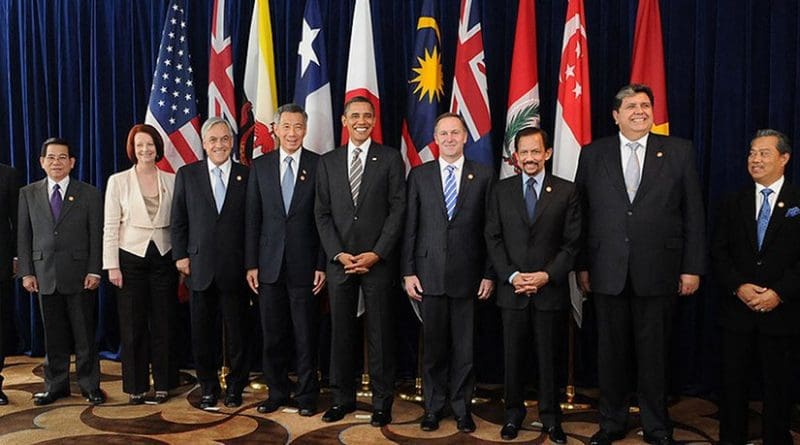Southeast Asia Trembles As Trans-Pacific Partnership Nears Completion – OpEd
As the sun began to rise in Georgia’s capital Atlanta on October 5th, trade bureaucrats from 12 nations put pen to paper and came one step closer to finalizing the “21st century trade agreement” known as the Trans Pacific Partnership (TPP). The TPP will eliminate tariffs and barriers to trade between the US, Japan, Australia, Peru, Malaysia, Vietnam, New Zealand, Chile, Singapore, Canada, Mexico, and Brunei Darussalam, putting 40% of the world economy under a consolidated economic framework.
But the TPP, despite being dubbed “the most progressive trade agreement in history,” would spell disaster for the environment and would presage a world in which corporations can sue governments for passing regulations to protect workers’ rights and the environment. TPP is a mammoth agreement that includes thousands of provisions, and one of the most menacing is the Investor State Dispute Settlement (ISDS) system, which would effectively allow corporations to sue governments for “damages” if regulations affect their bottom line. But while there has been much media hype revolving around the controversial ISDS, the greater issue of the TPP rests with the lack of enforceable measures to protect signatory nations’ environments, thereby threatening local ecosystems and undermining dedicated efforts to fighting climate change.
A threat to Southeast Asia’s biodiversity
The environmental consequences of TPP will be particularly acute in Southeast Asia, which contains some of the worlds most climate vulnerable economies.
In Vietnam, air pollution is a national crisis. Hanoi is widely considered the most polluted city in Southeast Asia, with concentrations of carcinogens many times the levels considered “safe.” Such pervasive pollution has meant that a growing number of urban-dwelling Vietnamese are also falling victim to cancer and respiratory diseases. Thousands of cars and motorcycles are added to the congested streets of Hanoi and Ho Chi Minh City annually, while public transportation remains antiquated, at best. Vietnam’s water sources are faring no better under the onslaught of industrial runoff. Less than 40% of the population has access to clean water supplies, and industrial pollution is rendering what water remains unsuitable even for agriculture.
Meanwhile, in Malaysia, illegal bauxite mining is expanding exponentially, driven by insatiable demand from China’s aluminum industry. Bauxite contains high levels of radioactive uranium, which is released during the purification process. Water supplies are being contaminated as illegal bauxite miners dispose of wastewater by dumping it into nearby rivers. Kuantan, the capital of Pahang province, has been especially hard-hit: the city sits at the mouth of the Kuantan river, which has turned red from the flood of heavy metals such as arsenic, cadmium, lead, mercury and uranium. Samples taken the from the waters surrounding Kuantan by Malaysia’s Department of Fisheries and Department of Chemistry “revealed a toxic bouquet of heavy metals contaminating the water”. Despite these findings the government continues to stall on adopting the necessary environmental regulations, citing the income the industry brings to the state, despite the fact that these economic benefits are far outweighed by the costs to human health and the environment.
TPP’s cheerleaders say that the agreement includes the strongest environmental protections of any trade agreement and is a “gold standard” by which other such deals should be measured. Chapter 12 of the agreement is devoted to comprehensive environmental protections covering “regions from tundra to island ecosystems, and from the world’s largest coral reefs to its largest rain forest,” according to a summary obtained by the New York Times. However, unlike the protections it extends to investors via the ISDS, there are no enforcement mechanisms for the meager nod it makes toward defending the environment. Characterized by language such as “commit” to enforcing environmental protections, the current agreement is unlikely to encourage countries such as Vietnam and Malaysia to oblige by environmental provisions and promote a model of economic growth based on sustainable development.
The US-Peru Free Trade Agreement, which contains provisions to curtail Peru’s illegal logging industry, confirms these concerns. The agreement has done nothing to halt the devastation of Peru’s forests, end the illegal expropriation of indigenous lands or stop the murders of anti-logging activists, and there is no reason to think that the TPP’s paper-thin assurances of environmental protection will be more than window-dressing to please environmental groups and at-risk constituencies. Peru serves as a stark reminder that trade agreements put trade first and the environment, public health and indigenous people’s rights second-to-last.
More than a dozen environmental groups have voiced their opposition to the TPP, arguing that the agreement would hasten ecological catastrophe while padding corporate coffers. According to Sierra Club Director Michael Brune, “the TPP’s environment chapter might look nice on the surface but will be hollow on the inside, and history gives us no reason to believe that TPP rules on conservation challenges such as the illegal timber or wildlife trade will ever be enforced”. Sustainable economic development can only occur within a framework of stringent environmental protections. But the TPP has shown its true colors as “a frontal assault on environmental and climate safeguards” sacrificing sustainable growth in a narrow-minded pursuit of economic interests.
*Carrie Winters is a British environmental research officer currently residing in Singapore with extensive knowledge of the Southeast Asia region.

